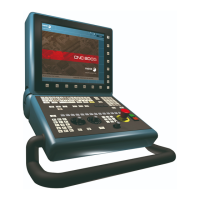Operating manual.
CNC 8060
CNC 8065
4.
AUTOMATIC MODE
Block search.
·108·
(REF: 1807)
4.6 Block search.
With block search, it is possible to recover the program history up to a particular block in such
way that if program execution is resumed at that block, it will do so with the same conditions
as if it were executed from the beginning.
When recovering the program history, the CNC reads it up to the indicated block activating
the "G" functions it reads along the way. Likewise, it sets the feedrate and spindle speed
conditions of the program and calculates the position where the axes should be. The M
functions are sent depending on how the machine is configured; they may be sent while
reading the program or at the end of the program.
Block search and canned cycles.
If a canned cycle is not selected as stop block, the block search only simulates the T, F, S
changes and the movement to the last point. The surface milling, grooving and profile
machining cycle, instead of simulating the movement to the last point, simulate a movement
to the point defined by the safety Z and the reference corner or profile entry point.
If a block containing a multiple machining cycle has been defined as a stop block, it is possible
to define the number of times that the machining operation is repeated. The block search
will end just before the beginning of the n-th modal cycle repeated in the multiple machining
operation.
Types of block search.
The CNC has two search modes, automatic and manual. See "4.3.2 Select the first and last
blocks of the execution." on page 90.
Automatic block search.
The automatic block search may be used to recover the program history up to the block where
the previous execution was canceled. The CNC remembers the block where interruption was
canceled, thus not being necessary to set the stop block.
Manual block search.
The manual block search may be used to recover the program history up to a particular block
of the program or of the subroutine, set by the operator. In this search, it is possible to set
as an ending condition to repeat the stop block a particular number of times, for example
multiple machining cycles, loops, etc.
Executing block search.
To recover the program history, proceed as follows:
1 Selecting the type of search: automatic or manual.
2 Selecting the stop block.
In the automatic block search, there is no need to select the stop block; by default, the
CNC runs the search up to the block where the program was interrupted.
The manual block search requires defining the point where the search will end. The stop
block may be in a subroutine. When selecting as stop block a block with repetition,
multiple machining, etc. it is possible to define the number of times that this block must
be repeated in order to end the search.
3 Selecting the starting block for the search. If the first block is not selected, the block search
starts at the beginning of the program.
4 Press the [CYCLE START] key to start the block search.
The CNC reads the program up to the stop block, activates the "G" functions that it reads,
sets the feedrate and spindle speed conditions and calculates the position where the
axes should be. The M functions are sent depending on how the machine is configured;
they may be sent while reading the program or at the end of the program.
5 Depending on how the treatment of functions M, H, F, S is configured, it may be necessary
to decide which ones are sent out to the PLC.
6 Reposition the axes to the point to resume execution.
7 Tool inspection may be accessed to change the machining conditions.

